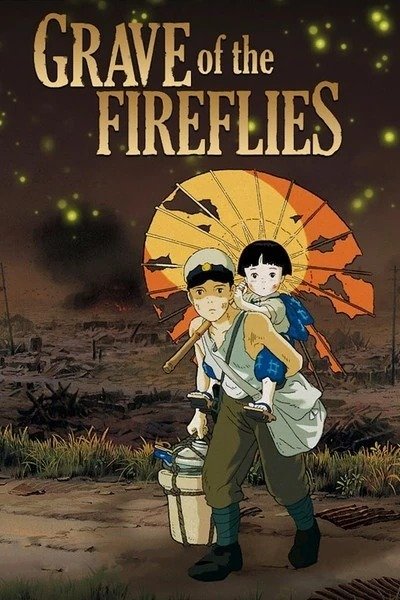NOOB FILM REVIEW - GRAVE OF THE FIREFLIES (1988) directed by ISAO TAKAHATA on Netflix

THE POETRY AND SUBTLETY IN ADDRESSING THE HORROR OF WAR
SYNOPSIS (Google)
A devastating meditation on the human cost of war, this animated tale follows Seita (Tsutomu Tatsumi), a teenager charged with the care of his younger sister, Setsuko (Ayano Shiraishi), after an American firebombing during World War II separates the two children from their parents. Their tale of survival is as heartbreaking as it is true to life. The siblings rely completely on each other and struggle against all odds to stay together and stay alive.
REVIEW
The synopsis says it all. But we all know about Studio Ghibli’s trademark in the way he tells his story. It is called “Ma”. Which are ‘pause’ and ‘calm’, for the viewer to better absorb the character and story. The stillness and melancholy further made the viewer develop empathy and catharsis.
The simple premise of family archetype; father, mother, brother, and sister, which belongs to a higher hierarchy of the state, in this case, the WWII Japanese Empire.
What happens to the main character’s family as the casualty of war marks its causality in the main narrative. The poetry portrays something as simple yet in a great way (and vivid!).
But that is just on the surface. The director and writer, Isao Takahata is subtle in telling of the subtext, which is the slow, gradual death of the real unadulterated Japanese (with the death of Setsuko and Seita, and earlier their selfless mother and father, who died in battle.) Symbolized by the burying of the fireflies and at the end, in spirits.
OF THE 'AMERICANIZATION'
Thus the gradual 'Americanization' of Japan, which is being shown subtly. Not told.
The can of sweets that contains the ashes of Setsuko is thrown away in the style of a baseball player. After the Japanese surrender, girls come back in colorful American skirts and the background song playing is 'Home Sweet Home' playing from a vinyl record player, while showing the lakeside cave where Seita mourning for his lost.
From the low humming of their bombers, raining down fiery explosives, which have a similar pattern to the fireflies yet projected from two opposite directions and sides. One is a horror from above and another one came out from Mother Nature. Binary opposition.
This reminded me of how Yasu Tanaka (a Japanese!) uses fireflies too, as a red-herring in MagiK. In Grave of the Fireflies, it is actually talking about the human lives that have perished.
This is an anti-war film. War. Where old men talking and young men dying. The death of Setsuko is also the death of innocent lives in the modern stage of war, compared to the more 'civilized' period of mankind where only the soldiers fought each other at the designated war zone, far from innocent civilians.
Also subtly shows how Miyazaki defies the Americans, coming from the WWII Japanese theater (and his experience dealing with Disney. Also, on the normalization of guns and murder through its portrayal on the screen) it is all for the right reasons. Yet the irony of it all is, if there were no bombings by the Americans, would this film be here at all?
Regardless, the film says of Ghibli's (and Miyazaki's) worldview and a display of civilization, social anthropology, socio-culture, and linguistics of the Japanese. Cinema.
Also brought me back to the Iranian war film, Track 143 directed by Narges Abyar, where the audience already knew about the death of her son, yet similar to Setsuko and Seita's death, how it is being revealed and screened at the end served as a satisfying payoff (although morbid).
Having just watched this film on Netflix made me want to suggest those having not watched it be listed as a cardinal sin and be burned at the stake. But like they say, despite this being a film from 1988, it is not an old film if you just watched it today.
Kinna related to one quote I bumped into recently from George Lucas saying, “Learning to make film is very easy. Learning what to make films about is very hard.” We see alot of effort concentrated on how to do things (CGI, AI etc) which suppose to be the side element of the main thing, which is the story. “Cinematic” yet not cinema.
Currently showing on Netflix.
This is a heartbreaking film but at the same time so beautiful because it shows us sibling love in its purest essence, love is a force that overcomes any adversity and that is why I prefer to believe that Seita and Setsuko are happy in paradise.
Yes. With the fireflies